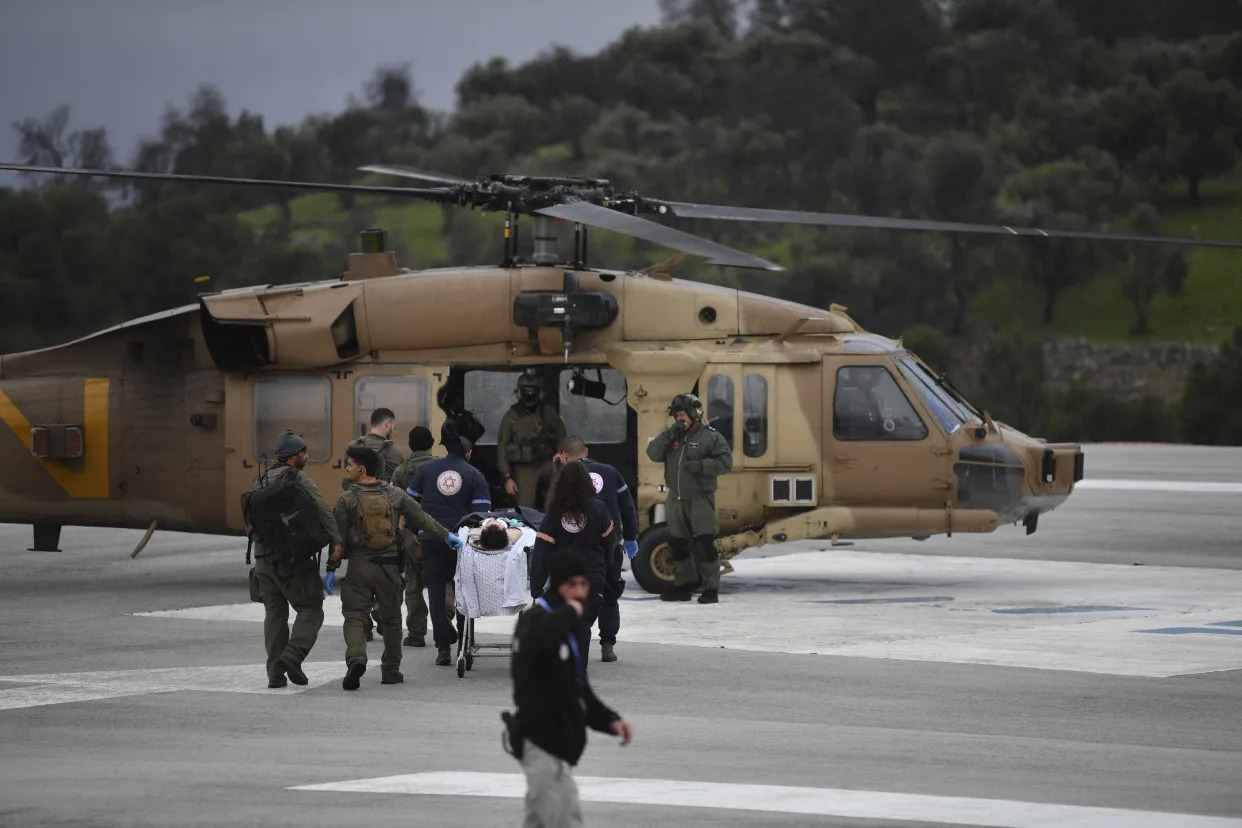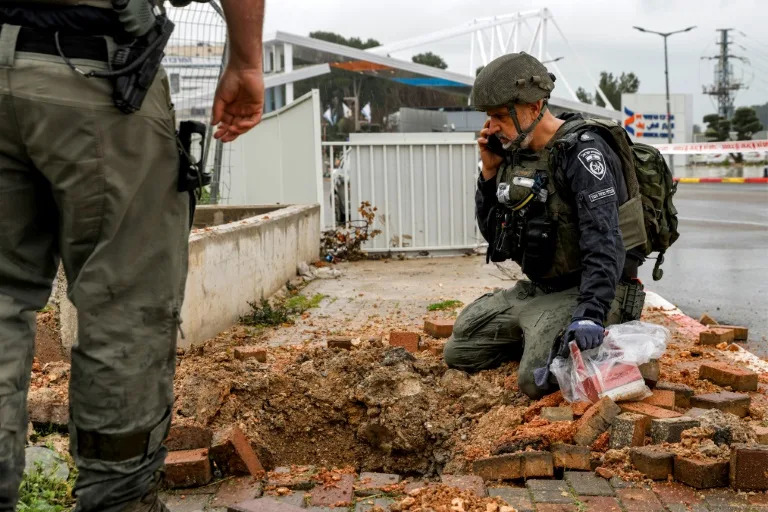The slow-simmering cross-border conflict between Lebanon’s Hezbollah militant group and Israeli forces escalated Wednesday, reviving fears that the daily clashes could expand into an all-out war.
An Israeli medical team evacuate a person injured by a rocket fired from Lebanon, at Ziv hospital in Safed, northern Israel, Wednesday, Feb. 14, 2024. Israeli media reported 1 killed and eight wounded in the rocket attack. The town, which is around 12 kilometers (7 miles) from the border is farther south than most of the daily border skirmishes with Lebanon's Hezbollah militant group.
A rocket fired from Lebanon struck the northern Israeli town of Safed, killing a 20-year-old female soldier and wounding at least eight people.
Israel responded with airstrikes that killed at least 10 people in southern Lebanon, including a Syrian woman, her two children, four members of another family and three Hezbollah fighters. At least nine people were wounded.
The cross-border violence was triggered by the Israel-Hamas war in Gaza, which in turn was set off by the Oct. 7 attack on southern Israel by Hamas, a Hezbollah ally.
Hezbollah did not claim responsibility for Wednesday's strike. But it has vowed to continue its attacks until there is a cease-fire in Gaza. Amid fears of a further escalation, here’s a look at the arsenals of the two sides:
WHAT ARE HEZBOLLAH’S MILITARY CAPABILITIES?
Hezbollah is the Arab world’s most significant paramilitary force with a robust internal structure as well as a sizable arsenal. Backed by Iran, its fighters have gained experience during Syria’s 13-year conflict in which they helped tip the balance of power in favor of government forces.
Hezbollah’s leader, Hassan Nasrallah, had boasted that the group has 100,000 fighters, though other estimates put its troop strength at less than half that. Israel wants Hezbollah to withdraw its elite Radwan Force from the border so tens of thousands Israelis displaced from northern towns and villages can return home.
Hezbollah holds a vast arsenal of mostly small, portable and unguided surface-to-surface artillery rockets, according to the Center for Strategic and International Studies, a Washington think tank. The U.S. and Israel estimate Hezbollah and other militant groups in Lebanon have some 150,000 missiles and rockets. Hezbollah also has been working on precision-guided missiles.
Hezbollah has previously launched drones into Israel and in 2006, hit an Israeli warship with a surface-to-sea missile. Its forces also have assault rifles, heavy machine guns, rocket-propelled grenades, roadside bombs and other weaponry.
During the current conflict, Hezbollah has frequently used Russian-made portable anti-tank Kornet missiles. More rarely, it has launched Burkan rockets that, according to Nasrallah, can carry a warhead that weighs between 300 kilograms (660 pounds) and 500 kilograms (1,100 pounds).
In recent weeks, Hezbollah has introduced new weapons including a surface-to-surface missile with a range of 10 kilometers (6 miles) and a warhead weighing 50 kilograms (110 pounds).
WHAT ARE ISRAEL’S MILITARY CAPABILITIES?
Israel’s military has long been supported by the United States, with $3.3 billion in annual funding, plus $500 million toward missile defense technology.
Israel is one of the best-armed nations in the wider Middle East. Its air force includes the advanced American F-35 fighter jet, missile defense batteries including the American-made Patriot, the Iron Dome rocket-defense system and a pair of missile-defense systems developed with the U.S., the Arrow and David's Sling.
Israel has armored personnel carriers and tanks, and a fleet of drones and other technology available to support any street-to-street battles.
Israel has some 170,000 troops typically on active duty and has called up some 360,000 reservists for the war — three-fourths of its estimated capacity, according to the International Institute for Strategic Studies, a British think tank. With the war now in its fifth month, many of those reservists have returned home.
Israel has also long maintained an undeclared nuclear weapons program.
HOW SERIOUS IS THE LATEST ESCALATION?
While most analysts believe there is little appetite for a full-blown war by either Hezbollah or Israel, there are fears that a miscalculation by either side could trigger a major escalation. The U.S., France and other countries have dispatched diplomats in recent weeks to try to tamp down tensions on the border.
Speaking on Tuesday, Nasrallah responded to threats by Israeli officials to launch an offensive if his group does not pull its forces back from the border. “If you expand (the conflict), we will expand," he said.
Wednesday's exchange of strikes, some of which hit relatively far from the border area, is a clear indication of the risks that the violence could spill out of control.
The two sides fought a 34-day war in 2006 that ended in a draw.
Cross-border fire kills Israeli soldier, 4 in Lebanon including children
An Israeli policeman inspects the impact crater left by a rocket fired from southern Lebanon in the northern city of Safed.
The Israeli military said Wednesday a soldier was killed in rocket fire from Lebanon, while Lebanese official media said three civilians and a Hezbollah fighter were killed in a series of Israeli strikes.
While the rocket fire was not immediately claimed, the exchanges raised fears of a broader conflict between Israel and the Iran-backed Hezbollah movement, which have been trading near daily cross-border fire since the Israel-Hamas war began in October.
The Israeli army said in a statement Sergeant Omer Sarah Benjo, 20, was killed "as a result of a (rocket) launch carried out from Lebanese territory on a base in northern Israel".
Fighter jets struck a series of "Hezbollah terror targets" in several areas of south Lebanon including Adshit and Sawwaneh, the military said.
Lebanon's state-run National News Agency (NNA) said Israeli warplanes targeted a house in Sawwaneh with two strikes, "leading to its destruction" and the death of three members of the same family, identifying them as a Syrian woman and her child, aged two, and stepchild, 13.
The NNA said another Israeli attack targeting Adshit killed one person, who Hezbollah announced was one of its fighters, and wounded 10 others, destroying a building and causing significant damage nearby.
- 'Heavy price' -
Israel's Magen David Adom emergency service had said seven people were wounded in fire from Lebanon, five of them in the town of Safed.
An AFP photographer saw medics and troops evacuating a wounded person by military helicopter from Safed's Ziv hospital.
Israeli army chief Herzi Halevi said after meeting commanders near the Lebanese border that Israel's "next campaign will be very much on the offensive, and we will use all the tools and all capabilities".
"We are intensifying the strikes all the time, and Hezbollah are paying an increasingly heavy price," he said in a statement.
Senior Hezbollah official Hashem Safieddine said Wednesday that "this aggression... will not go unanswered".
A day earlier, Hezbollah chief Hassan Nasrallah said that fire from southern Lebanon would end "when the attack on Gaza stops and there is a ceasefire" between the group's Palestinian allies Hamas and arch-foe Israel.
"If they (Israel) broaden the confrontation, we will do the same," Nasrallah warned.
Tens of thousands of people have been displaced on both sides of the border amid soaring regional tensions.
Fears have been growing of another full-blown conflict between Israel and Hezbollah, which last went to war in 2006.
- 'Diplomatic path' -
The UN secretary-general's spokesman Stephane Dujarric warned "the recent escalation is dangerous indeed and should stop."
Peacekeepers from the United Nations mission in Lebanon had noticed "a concerning shift in the exchanges of fire between the Israeli armed forces and armed groups in Lebanon", he added.
The attacks included the "targeting of areas far from the Blue Line", he said, referring to the withdrawal line demarcated by the UN in 2000 after Israeli troops pulled out of southern Lebanon.
State Department spokesman Matthew Miller said Washington would continue to push for a "diplomatic path" to resolve the cross-border tensions.
"One of our primary objectives from the outset of this conflict is to see that it not be widened," he added.
US National Security Advisor Jake Sullivan said that "Hezbollah has been firing deeper and deeper into Israel," adding that the threat from the Iran-backed group had become "acute".
The cross-border violence has killed at least 248 people on the Lebanese side, most of them Hezbollah fighters but also including 33 civilians, according to an AFP tally.
On the Israeli side, 10 soldiers and six civilians have been killed, according to the Israeli army.




